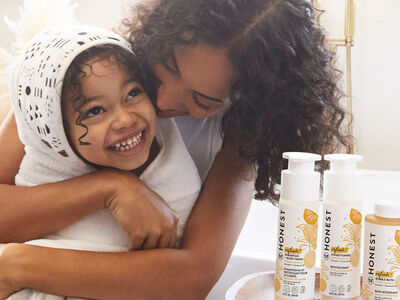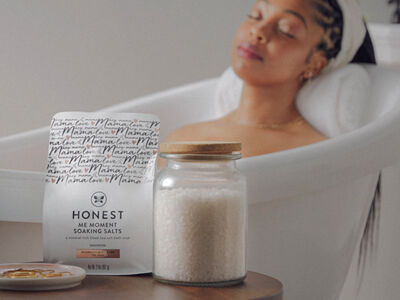If you’ve ever stepped out into a warm, sunny day and instantly felt better about your life, then you already know that something as simple as sunlight can be wonderfully good for adults.
But is the same true for babies and the sun?
The short answer: the right balance of sun exposure and shade depends on your baby’s age, the protective measures you take, and even factors like the weather.
Fortunately, with the right facts and guidance, you and your little one can enjoy all the awesome benefits of sun time while still protecting that delicate baby skin.
What Is the Ideal Sun Time for Newborn Babies?
Your newborn baby is precious cargo, and you understandably want to keep them safe and sound as they adjust to a whole new world (sunshine included).
So, how much sun exposure is right for a newborn? In fact, during the first few months of their life, less is more when it comes to babies and sun. The American Academy of Pediatrics recommends babies younger than six months be kept out of direct sunlight as much as possible.
While sun exposure can have benefits for older babies and children, too much exposure early on can cause uncomfortable burns to a baby’s sensitive skin. In some cases, too much sun in early infancy can even increase a baby’s long-term risk of skin cancer.
Once your baby is older than six months, you can begin exposing your child to direct sunlight more frequently. To maximize the potential benefits of sunshine time while avoiding the risks, however, be intentional when deciding when and how long to play in the sun. Taking precautions whenever possible is always a bright idea when it comes to the sun.
What to Consider When Choosing Baby’s Sun Time
Your growing little guy or gal can be incredibly strong (take the increasing grip strength of those tiny hands, for example). However, the sun’s strength is also an important measure of how much sun exposure your little one can take.
Several factors can affect the sun’s strength on any given day. According to the American Cancer Society, the potency of the sun’s ultraviolet (UV) rays may be affected by:
- Weather – Cloud coverage may reduce UV exposure in comparison to a clear day, but babies (and adults, for that matter) can still sunburn on a cloudy day.
- Time of day – The sun’s UV rays are most potent during the middle of the day, typically between 10 am–4 pm. Therefore, it’s usually best to play outside when the sun is lower in the sky, such as in the morning or late afternoon.
- Season – Spring and summer can mean a higher risk of exposure to harmful UV radiation. That said, it’s still important to take precautions on sunny days in fall and winter.
- Latitude – Generally speaking, UV exposure tends to lessen the farther you live from the equator. So if you live in Ecuador, you’ll want to provide more sun protection for your baby than if you live in Canada.
- Altitude – If you live at a higher elevation from sea level, that can also increase your risk of UV exposure.
- The reflectiveness of nearby surfaces – If you spend time around more reflective services (water, glass windows, snow, pavement, sand, etc.), those surfaces can reflect UV rays back toward you, exposing you to more harmful rays.
One helpful way to check the sun’s strength is to check your local UV index, usually found in your favorite weather app or forecast.
The UV index is designed to help you judge the intensity of sunlight in your area on a given day. On a scale from 1 to 11+, a number at the lower end means you need less sun protection, while numbers in the medium-to-high range indicate you should either use greater sun protection or stay indoors.
How to Protect Baby from Too Much Sun
Once your baby is old enough, you might be gladly anticipating days of fun in the sun. Before you and the little one step out, however, it’s important to know what precautions you should take.
Much like adults, too much sun exposure can lead to painful burns and long-term effects in babies. To enjoy time outside with your little one while reducing the risks, try these sun safety tips to protect their sensitive skin.
#1 Use Shade to Limit Time in the Sun
One easy way to limit harmful UV exposure is by spending less time in direct sunlight.
When possible, try choosing shorter outdoor activities with your baby, such as opting for a fifteen-minute walk instead of a two-hour stroll.
For longer activities like a day at the beach or a picnic, you can limit UV exposure by finding shady areas to retreat to. You can make use of existing shade from things like trees and buildings, or create your own with more common beach essentials like a beach umbrella or a shade tent.
A patch of shade not only helps protect baby and you from UV rays—it also gives you a cooler place to relax on a hot day.
#2 Protect Their Skin with Clothes and Hats
For a baby on the move, you can protect their skin from harmful sun exposure with sun protective clothing. Both sun hats and full-coverage clothing can help protect your baby from the uncomfortable effects of too much sun.
Try breathable, full coverage clothing like a long-sleeve cotton shirt and cotton pants.
#3 Protect Their Eyes With Sunglasses
Those cute baby sunnies may look adorable, but they’re more than just a cute accessory. Sunglasses can help to protect baby’s eyes—and the sensitive skin around those eyes—from harmful UV rays.
Wearing sunglasses early on and throughout their life can help keep your baby’s eyes healthy, and even help prevent eye issues later in life like macular degeneration.
So give your baby some extra style, and extra eye protection, with a pair of little sunglasses.
Bonus points if you model good behavior for baby and protect your own eyes too with some killer shades—because you deserve eye protection, too.
#4 Use Sunscreen Every Day
Aside from coming in super-cute bottles that give you some skin care envy, baby-safe sunscreens can be an especially helpful tool in providing sun protection. The American Cancer Society recommends using a sunscreen of at least SPF 30 to protect skin from painful sunburns.
Related research suggests that you can level up your baby’s sunscreen game and make it even more effective by:
- Applying sunscreen at least 30 minutes before you take your baby out into the sun.
- Re-applying every two hours.
- Making sure to cover every area of skin exposed to the sun. Smooth the sunscreen under the edge of baby’s clothing to achieve full coverage and avoid any surprise sunburns.
When your baby is sleeping soundly after a fun day in the sun, you’ll thank yourself (and your sunscreen) for keeping you both burn-free.
Benefits of Sun Exposure for Babies
Every parent wants to approach newborn sun exposure with a wealth of knowledge about how to protect their kids from uncomfortable sunburns and other side effects of too much sun.
But once your child is old enough to enjoy some sun time—and you take the right precautions—some sun exposure can actually be beneficial.
For children older than six months, appropriate levels of sun exposure can offer both mental and physical benefits. According to some studies, exposure to UV rays can:
- Improve vitamin D synthesis
- Help foster a feeling of well-being
- Encourage regular circadian rhythms (sleep-wake cycles)
So, how much sun exposure can provide these benefits for babies and children?
More research is needed on the benefits as a whole. However, one study suggests that less than thirty minutes of afternoon sunlight exposure every week could be sufficient to help boost your baby’s ability to synthesize vitamin D. Still, experts caution that sunlight can never replace the vitamin D your baby should get from their daily diet.
Studies like this one seem to agree that a little sun exposure can go a long way for babies.
How to Enjoy Fun in the Sun
Your baby is old enough now, you’ve acquired some baby sunscreen and protective clothing, and you’re ready to explore the bright outdoors. Enjoying the sun together can also be an opportunity to break from the routine and bond with your baby. But where should you start?
Here are some fun, accessible ideas to try with your baby:
- Toss (or roll) a ball around outside your home
- Break out the sidewalk chalk
- Enjoy a stroll, stopping to talk about colors, plants, and anything else that interests your baby
- Visit a local park, especially if it has a play structure or swing set
As long as you’re taking plenty of precautions, you can’t go wrong with some easy, breezy fun in the sun.
Choose Honest for Sun-Safety and Beyond
Being a parent can be a bit like being a superhero. You juggle childcare, housework, your own work, all your other relationships, and taking care of yourself.
First off, wow. If someone hasn’t said it today, you rock.
Secondly, we’ve got a product that might make one part of your life easier. Offering SPF 30 protection, the Honest CCc Clean Corrective with Vitamin C Tinted Moisturizer
is also a 6-in-1 skincare-hybrid tinted moisturizer—so you can take care of your own skin alongside your baby’s.
At Honest, we’ve been committed to high-quality products made from clean ingredients since the first baby wipe we made. As we expanded to bath & body, beauty, moisturizer with SPF, and cleaning and other products, we remain committed to doing our part to build an environmentally sustainable and socially conscious world.
We’ve got your back, so you can have your baby’s back.
Sources:
How do I protect myself from ultraviolet (UV) rays? American Cancer Society. (n.d.). Retrieved June 6, 2022, from https://www.cancer.org/healthy/be-safe-in-sun/uv-protection.html
Jindal, A. K., Gupta, A., Vinay, K., & Bishnoi, A. (2020). Sun Exposure in Children: Balancing the Benefits and Harms. Indian dermatology online journal, 11(1), 94–98. https://doi.org/10.4103/idoj.IDOJ_206_19
Sweet, J. (2019, February 26). 7 tips to stop macular degeneration. Healthline. Retrieved June 7, 2022, from https://www.healthline.com/health-news/7-tips-for-macular-degeneration-to-know-before-you-go-on-vacation
True or false: Dark-skinned people don't need sunscreen. Winchester Hospital. (n.d.). Retrieved June 6, 2022, from https://www.winchesterhospital.org/health-library/article?id=157004#:~:text=Health%20experts%20advise%20everyone%2C%20regardless,spots%20and%20wrinkles%E2%80%94and%20cancer%20.
Hartstein LE, Behn CD, Akacem LD, Stack N, Wright KP, & LeBourgeois MK. (2022, January 8). High sensitivity of melatonin suppression response to evening light in preschool-aged children. Journal of pineal research. Retrieved June 8, 2022, from https://pubmed.ncbi.nlm.nih.gov/34997782/
We aim to provide you with the most honest and credible information possible. This article was reviewed for accuracy by The Honest Team and was written based on trusted sources that are linked at the bottom of the article.
blog_review_statement









